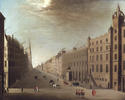 Trongate was the heart of secular Glasgow for centuries, the town house having been established there in 1400 and the Tolbooth (courts and gaol) erected in 1626. Glasgow's economic growth in the mid 18th century led to the demolition of the old West Port and the opening up of new residential streets to the north of Argyle Street (Virginia, Miller, Queen and Buchanan Streets) and commercial/industrial streets south towards the River Clyde (Dunlop and Maxwell Streets).
Trongate was the heart of secular Glasgow for centuries, the town house having been established there in 1400 and the Tolbooth (courts and gaol) erected in 1626. Glasgow's economic growth in the mid 18th century led to the demolition of the old West Port and the opening up of new residential streets to the north of Argyle Street (Virginia, Miller, Queen and Buchanan Streets) and commercial/industrial streets south towards the River Clyde (Dunlop and Maxwell Streets).
 As the city's leading merchants built stately new townhouses in and around Argyle Street, the centre of commercial activity remained in Trongate at Glasgow Cross. In 1780 a society of Glasgow merchants established the Tontine Hotel with its famed coffee room where Tobacco Lords and other prominent manufacturers, importers and exporters formed Glasgow's first Exchange. At the Tontine Hotel the city's mercantile elite conducted business inside over glasses of claret within the arcaded piazzas or simply on the smart "plainstanes" of the footpath.
As the city's leading merchants built stately new townhouses in and around Argyle Street, the centre of commercial activity remained in Trongate at Glasgow Cross. In 1780 a society of Glasgow merchants established the Tontine Hotel with its famed coffee room where Tobacco Lords and other prominent manufacturers, importers and exporters formed Glasgow's first Exchange. At the Tontine Hotel the city's mercantile elite conducted business inside over glasses of claret within the arcaded piazzas or simply on the smart "plainstanes" of the footpath.
 By the early 19th century businesses were following the residential migration to the north and west and by the time the Cuninghame mansion in Queen Street was converted into the Royal Exchange (c.1827), Trongate's role in the city's economy had been eclipsed. By 1830 Ingram Street was the home of four major banks, as well as the Assembly Rooms and Hutchesons' Hospital, and was grandly terminated by Royal Exchange Square, an elegant development of business chambers and shops flanking the Greek Ionic temple of the Royal Bank of Scotland.
By the early 19th century businesses were following the residential migration to the north and west and by the time the Cuninghame mansion in Queen Street was converted into the Royal Exchange (c.1827), Trongate's role in the city's economy had been eclipsed. By 1830 Ingram Street was the home of four major banks, as well as the Assembly Rooms and Hutchesons' Hospital, and was grandly terminated by Royal Exchange Square, an elegant development of business chambers and shops flanking the Greek Ionic temple of the Royal Bank of Scotland.